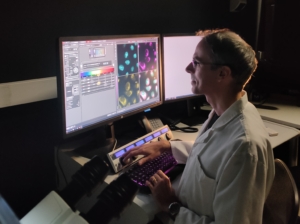World Creativity & Innovation Day | April 21
Waterborne biofouling is a global concern in several industrial sectors responsible for:
- Losses in systems efficiency, leading to substantial economic and energy costs (e.g., polymeric foam filters employed in air conditioning, water treatment or even Heat & Moisture Exchange Medical Filters).
- Premature degradation (biocorrosion).
- Biocontamination that’s promotes outbreaks and human infections.
Conventional solutions suffer severe restrictions on their use due to allied environmental harms, as they rely on releasing toxic and cumulative antimicrobial chemical agents.
The present invention refers to a new process to produce non-leaching polymeric foam filters through the chemical grafting of antifouling agents in the polymeric foam structure, presenting itself as an environmental-friendly and long-lasting alternative to the control of biofouling.
The biocidal foams produced by this process using a commercial biocide with a broad spectrum of action have demonstrated:
- Effective immobilization of the biocide and minimization of its leaching (3 times less when compared to a conventional foam – standard test: 45 days of immersion in water).
- Proven ability to include a relatively high agent content (greater than 3wt.%).
- Proven ability to increase its bioactivity against microfouling (e.g., pathogenic bacteria) and macrofouling (e.g., crustaceans)
- Biofouling Inhibition on surfaces of at least 95% after 24 hours of exposure to contaminated fluid media, preferably containing water.
- No retrofitting action is required in a conventional industrial foam process.
The invented process to produce new non-leaching biocidal polymeric foam allows for the first time to graft commercially available or emergent antifouling agents in a polymeric foam, never tough to be able to, and at higher contents, allowing two main innovative functionalities: i) increase the spectrum of antifouling protection of foam filters structures against micro- and macrofouling; ii) minimize the releasing of the agent into the fluid media, allowing for a long-lasting effect minimizing at the same time its environmental impact.
How does the research you perform allows you to be creative?
My, or any, research activity, by its very nature, allows us to carry out and implement new ideas, even if no one believes it is possible and even if many of these turn out in the worst way. This invention was a test of an idea to a need or gap in the field with no expectations that produced unexpected results that paved the way for other research findings or exploration of ideas. The addictive beauty of research is that it is a boiling world of endless new ideas that will always surprise us in the most diverse areas.

Cystic Fibrosis (or CF) is a rare genetic disease which has the potential to significantly shorten people’s life span and life quality by severely affecting the lungs, gut and other organs. The cause for CF is well known: mutations in a gene called CFTR. Most CF individuals can be treated with available drugs, to a limited extent. We discovered that the efficacy of current CFTR-targeting drugs is enhanced in cellular models of CF by inhibiting a kinase called GRK5. Importantly, the inhibitor is a small molecule (that we call 9g), suggesting that it might be suitable to supplement the current therapy. We have also identified around 200 other genes which may regulate mutant CFTR in the cell.
Our invention is innovative from several points of view. First, because we discovered a completely new CF therapeutic target with the potential to improve the health and quality of life of CF individuals with the most common CFTR mutation. Second, because the additional 200 genes are potential novel players in CF and CFTR biology – regardless of being related to GRK5 or not – which deserve additional research. Finally, because the whole research project stemmed from a new image-based cellular assay harnessing the technologies of high content screening and RNA interference. I believe this new experimental approach was key to our success and there may be important repercussions regarding biomedical research and economic potential.
Scientific research is always an exercise of human creativity. After all, research is all about finding out missing information, clarifying mechanisms, and, in my case, understanding the mechanisms which underlie life. Therefore, I strive to be creative every single day. Sometimes that takes the form of designing the best experimental layout to answer open questions about CFTR biology, other times that is about writing software to extract quantitative information about how cells react to a small molecule in a microscopy dataset, and some other times it is about setting up a research grant proposal which includes new assays aimed at understanding how the GRK5 signaling pathway works in the cell. Scientific discoveries always require one to place new hypotheses and consider that our work subject may hold secrets no one has contemplated before.

- Elisabete R. Silva’s patent application: Silva E. R., Bordado J. C. M., Ferreira O., Calhorda M. J., Rijo P. Non-leaching biocidal foams with anti-fouling activity, their production and uses (Translation). Patent pending, PT116986, 2022.Applicants: Instituto Superior Técnico da Universidade de Lisboa, Universidade Lusófona (COFAC) Faculdade de Ciências da Universidade de Lisboa.
- Hugo Botelho’s international patent: Amaral MD, Botelho HM, Lopes-Pacheco M, Pinto MC. Method of identifying agents for the treatment of cystic fibrosis caused by the mutation F508del. PCT/IB2023/051813 (Reference at the International Bureau of WIPO).


